The Rising Sea in Kiribati
Catching a few winks of shuteye leaning up against the inside of the elevator as at it makes its climb to the newsroom floor is a good way to revitalize oneself the first morning after returning from a week out on-assignment. That is, as long the means of support is one of the three elevator walls and not the door.
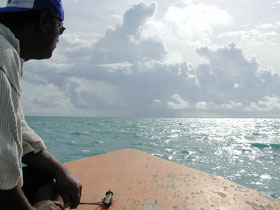 The door opened and dragged across my left cheek until I tumbled out. I opened my eyes to a pair of black high heels. Not a scuff on them. Must be junior reporter Junko's, I thought.
The door opened and dragged across my left cheek until I tumbled out. I opened my eyes to a pair of black high heels. Not a scuff on them. Must be junior reporter Junko's, I thought.
"I see you made it back from your sea-level rise investigation in Kiribati in fine form," she said.
"I think I am the object of someone's love," I announced. I rolled over onto my back and wiped my lips with the back of my right wrist.
"Who?" She stared down, hands on hips.
"The JAL stewardess from my return flight."
"Why?"
"She offered me a second piece of fish during dinner. I know she didn't do the same for anyone else."
"Well, she probably hadn't ever seen anyone consume alcohol at such a rate as you. Then, it is likely that she figured a second piece of fish was all that was going to keep your blood alcohol level at a point where she wouldn't have to drag your sorry alcoholic corpse to the clinic herself once the plane landed."
"So you agree then. It's love."
Junko squinted. I turned onto my side to reach my smokes in my front jacket pocket.
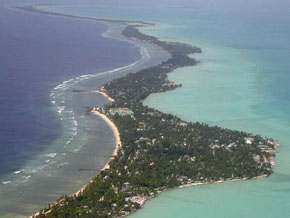 Touea Tanaki runs the clothing material under the needle of her manual Singer sewing machine. The heavy-set woman sits inside her small open shelter of wood, thatch, and rushes. It is no larger than a single bedroom and is elevated a few feet off the ground. Her four children play around their small property on the island of Teaoraieka. It is one of a series of islands, linked by causeways, that forms boomerang-shaped Tarawa Atoll in the South Pacific nation of Kiribati.
Touea Tanaki runs the clothing material under the needle of her manual Singer sewing machine. The heavy-set woman sits inside her small open shelter of wood, thatch, and rushes. It is no larger than a single bedroom and is elevated a few feet off the ground. Her four children play around their small property on the island of Teaoraieka. It is one of a series of islands, linked by causeways, that forms boomerang-shaped Tarawa Atoll in the South Pacific nation of Kiribati.
A swift breeze comes off the palm tree-lined lagoon. The lagoon is at her back as she works. Now it is low tide and the waves lap up onto the shore at a comfortable 10 yards from her property. Even at high tide, watermarks show that the tide falls well below her makeshift five-foot seawall.
But in both January of this year and August of last year, large storms sent torrents of seawater across her property and all the way back to the main road. This road is approximately the midpoint of the island, an island whose total width from lagoon to ocean is about the length of a football field. Most of the islands that link Tarawa's roughly 50-mile length are not much wider. The lagoon is a turquoise blue. The ocean is a deeper blue with a large shallow reef extending outward a few hundred yards.
During these storms, other damage was noted on Tarawa: near the wharf at Tarawa's south tip a pump house was washed into the lagoon and just a bit south some brick government buildings were swept into the lagoon.
"I am afraid. But I can't go anywhere else," Touea says of the recent activity. Her skin deeply darkened by the perpetual sun, she only remembers one other time in her 37 years on this island that the ocean crossed all the way to the main road. That was in late 1970s.
Kiribati is one of the countries being threatened by global sea-level rise. Scientists have warned since 1988 that the "greenhouse" effect could increase sea levels from 2 to 9 mm per year. Recent estimates from Colorado University's Institute for Arctic and Alpine Research have said that sea levels could rise by 28 cm over the next 100 years. This might be well and good for scientists to debate and banter about amongst one another at atmospheric conferences. But the big questions for the local populace of the low-lying countries of the South Pacific (with peoples that have been living on these islands for hundreds of years) are: Is this really happening? And, if so, at what point do we build the ark?
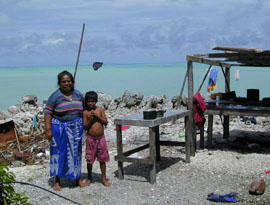 Over the years that she has lived on this property, Touea's life has been pretty simple: gather coconuts, make clothing for her children, collect rainwater, and maintain some means of a shelter - the essentials of subsistence living in a land of nearly no natural resources.
Over the years that she has lived on this property, Touea's life has been pretty simple: gather coconuts, make clothing for her children, collect rainwater, and maintain some means of a shelter - the essentials of subsistence living in a land of nearly no natural resources.
But now things are a bit in flux. Her seawall has collapsed twice in both of the recent storms. Because building materials are scarce, garbage (engine parts and other small pieces of scrap metal) is used in the construction of the wall. A lot of these "building materials" are scattered around her property from the last collapse of the wall. After the second time, she moved her shelter back from the seawall a few yards.
Islands in the South Pacific are susceptible to this activity for a number of reasons. Some islands, such as these atoll islands of Kiribati, rise not much more than 8 or 12 feet above sea level and are composed of easily transported sand sediments. As a result, large cyclones or storm surges can wash over the islands and erode large sections of existing landforms. A rise in sea levels will only magnify these events. With land space already scarce and the large majority of the populations living near the shores, this is a huge problem. Compounding this is the fact that the supply of potable water relies on low and unreliable rainfall or on shallow groundwater lenses. These lenses would then become susceptible to seawater intrusion should sea levels rise. Additionally, with this region being in the "ring of fire," tectonic and volcanic activity is causing some islands to sink and others to rise.
With all these factors providing a convoluted mix of motion in a number of directions, developing a verifiable pattern of activity is going to take the scientific community some time - perhaps as much as 20 years. But for the time being, hard evidence that it is actually happening is hard to come by. Is the recent damage the result of storms that have been enhanced by sea-level rise? Or is it merely the result of large storms that coincidentally have occurred at around the same time?
This lack of certainty has led to skepticism for some. "It's a hoax," says one worker at Tarawa's wharf on the island of Betio. "I would rather forget about it."
His views are not isolated. That is because Kiribati itself is highly isolated and for the average person things like greenhouse gases and sea-level rise take a back seat to concrete things like coconut cultivation and catching tuna.
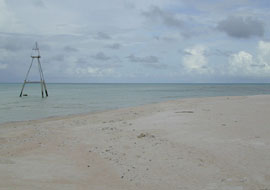 In looking around Tarawa though this sort of thinking is not at all illogical. Prior to the recent damage, the only evidence of any kind of a disturbance was that which befell the island of Bikeman. After the completion of the Nippon Causeway (Tarawa's longest causeway) in the mid-1980s, the island almost nearly disappeared. "After they built the causeway, it dissolved. It just started getting smaller and smaller," says Rurutaake Etuati, a 38-year old driver living on Tarawa.
In looking around Tarawa though this sort of thinking is not at all illogical. Prior to the recent damage, the only evidence of any kind of a disturbance was that which befell the island of Bikeman. After the completion of the Nippon Causeway (Tarawa's longest causeway) in the mid-1980s, the island almost nearly disappeared. "After they built the causeway, it dissolved. It just started getting smaller and smaller," says Rurutaake Etuati, a 38-year old driver living on Tarawa.
The theory is that the construction of the causeway disrupted the rate of water flow and sand deposition patterns between the ocean and the lagoon during the changing high and low tides. As a result, sand was taken from Bikeman and deposited somewhere else within the lagoon. Thus, its disappearance was not the result not of sea-level rise.
Bikeman is an isolated island about 5 miles from Tarawa's coast in the lagoon. In its heyday over 20 years ago, the island was full of coconut trees and residents of Tarawa would go by ferry to the island on weekends for picnics. Today Bikeman is eerie. Its size is about that of a strip mall parking lot. This represents a mere fraction of the original island, whose size once rivaled those on Tarawa's mainland. The island's one remaining feature is a sand shoal that rises perhaps five feet above the lagoon's level at low tide. A steel tripod signaling beacon stands in the island's shallow waters. It used to mark the center of the island. Thousands of broken shells have been deposited on its shore at various tide elevations. There are no coconut trees. There really isn't anything there to speak of. Well, other than a glaring example of how fragile Kiribati's environment is.
Thus far, monitoring results of sea levels have not revealed much. Short-term results from the South Pacific Sea Level and Climate Monitoring Project have shown increases in sea levels for some regions of the South Pacific but have also shown decreases for sea levels in Kiribati. The Project though maintains that such findings are likely due to such disruptions in the ocean-atmosphere system as El Nino and that significant data will only be the result of long-term monitoring. Hence, beneficial information is a long ways off.
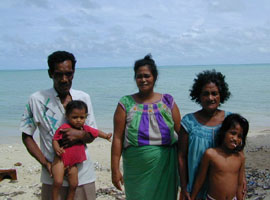 But Tawaia Tirikai wants to know what is going on now and what he should do. His property sits just down the street from Touea's. Like Touea, he has moved his shelter following the recent storms. Only his hammock, boat, some wood pallets, tires, and other miscellaneous items sit on his property at the water's edge. But unlike her, he moved it all the way back across to the other side of the road. The thin 55-year old, head of a family of five, says, "We are afraid. We have noticed the increase. Maybe someday..."
But Tawaia Tirikai wants to know what is going on now and what he should do. His property sits just down the street from Touea's. Like Touea, he has moved his shelter following the recent storms. Only his hammock, boat, some wood pallets, tires, and other miscellaneous items sit on his property at the water's edge. But unlike her, he moved it all the way back across to the other side of the road. The thin 55-year old, head of a family of five, says, "We are afraid. We have noticed the increase. Maybe someday..."
The thought that Tawaia does not want to complete verbally is that maybe someday his land, his island, and his entire country will be washed over by the Pacific Ocean. He is not aware of the greenhouse effect. All he knows is that in the last 6 months, he's had water crossing his property, at times reaching as deep as his shin.
He doesn't have any concrete plans for the future. But does have one wish for his family: "We want to find a better place. Someplace with mountains."

